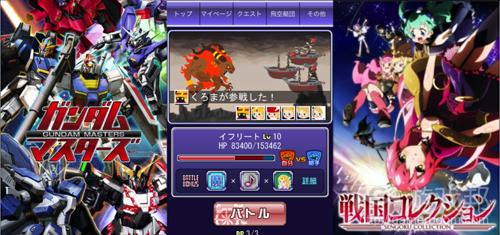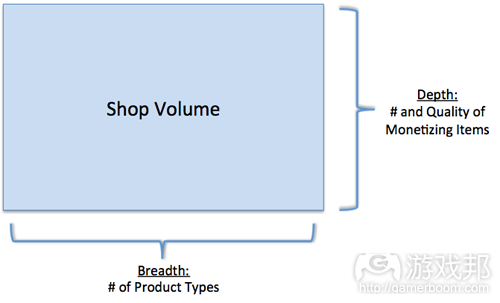阐述12个重要的手机游戏赢利概念
作者:Joseph Kim
你准备好升级你的手机应用赢利策略了吗?
2011年10月,一篇介绍DeNA如何引领日本手机游戏市场的文章指出,DeNA采用了几个关键的赢利策略:
1、高ARPU(每用户平均收入):据说DeNA的游戏的ARPU高达12美元——这有力地说明了,DeNA一定为他们的游戏精心设计了一套独特的赢利策略。
2、玩家心理学:解释了玩家压力的概念(“压力和解压”)以及玩家反感赢利策略产生的影响。
3、玩家群:主张对不同的“玩家类型”采取不同的措施。第三方分析公司如Playnomics和Playhaven最近执行了一种“玩家类型细分与目标选择”方案。
我认为,这篇文章和其他关于日本手机游戏的类似报道应该已经提醒我们,游戏赢利策略背后有一整套日本开发者深谙而我们却非常陌生的科学体系。例如:
本土化要求:这不是说同一款手机游戏在日本能挣到12美元ARPU,日本之外的国家也能挣到这么多,但我认为相同的策略经过适当的修改和表现,也可以运用到美国市场(例如,GREE的《Modern War》在今年2月份经过修改,据说ARPDAU翻倍不止)。
卡牌战斗游戏设计的精微之处:我认为日本游戏的设计中有许多非常微妙和复杂之处(游戏邦注:例如,对日本手机游戏行业收益贡献最大的卡牌战斗游戏),那是日本之外的国家还没掌握的。
例如,日本Mobage(DeNA)的卡牌战斗游戏(《Gundam Masters》、《Final Fantasy Brigade》和《Sengoku Collection》):
事实上,DeNA的管理总监小林健二在采访中曾经明确地指出,Zynga并不太精通如何让游戏赢利:
“我认为Zynga并没有真正地研究赢利策略。我觉得那些不了解日本市场的人以为日本付费玩家都疯了,但事实并非如此。你真的应该好好研究,什么时候让玩家花钱会他们感到最快乐。”
难怪现在世界上最赚钱的游戏就是日本Gungho的《Puzzles & Dragon》,据报道,该游戏的日收益高达490万美元。
所以,我们与日本开发者的差距到底在哪里?我们怎么迎头赶上?我不敢说我知道所有秘密,但我想不妨借此文(本文共有三部分)给大家指一条正确的方向。
12个重要的手机赢利概念:
本文将介绍有助于优化你的手机应用赢利策略的12个概念。这些概念虽然主要用于手机游戏,但我认为它们也可能运用到其他手机应用中。
另外,为了使本文内容更具条理性,我把这12个概念划分为3个精通级别,本文的每个部分都只介绍一个级别。
本部分将重点解释赢利概念的第1级,其内容如下:
1、机制设计
2、沉浸感重于赢利
3、商店容积、赢利能力
4、用户流程
1、机制设计
在手机游戏开发的最初阶段,就应该考虑到赢利机制。另外,应该非常明确游戏的赢利机制是什么,或者至少要认真假设这些机制的赢利效果如何。
关键问题:根据你正在开发的游戏(或应用)的类型,你认为关键的赢利机制是否能产生足够让游戏成功的收益?
1、什么是游戏/应用类型?
玩家留存率高的游戏(如《Subway Surfers)或病毒传播力强的游戏(如《Candy Crush Saga》)不一定具有像硬核RPG(如《Rage of Bahamut》)一样强的赢利能力,但显然必须具有非常强的竞争力。
2、你能胜出吗?
对于特定的游戏/应用,你必须保证你的使用的赢利机制能打败同类竞争对手和其他大部分非同类的竞争对手(收益排行榜前100名)。
“知己知彼,百战不殆”——孙子
这个概念的重点是,从一开始就要非常明确,在竞争越来越激烈的手机游戏市场,你的游戏有多少胜算。
2、沉浸感重于赢利
根据这个概念,游戏必须总是先提高玩家沉浸感和留存率,再考虑赢利。为此,你的游戏必须吸引玩家,能够让他们重复地玩,这样你才能在之后轻易地让他们掏钱。
就像毒贩子通常会拿出一点样品让顾客尝个鲜,等他们上瘾了再让他们付钱,推出赢利策略以前必须先让玩家迷上你的游戏。
然而,我讨厌这个概念的原因有两个:1、这个概念已经被用滥了,行业大会发言人、“专家学者”和广告商都经常提到它;2、太多手机游戏开发者以此为借口,不认真思考游戏赢利策略和改进游戏表现。
在使用这个概念时,你的手机游戏发布策略应该把保证沉浸感和留存率当作优先任务,然后再认真执行各种赢利特征。所以,高风险的赢利特征或事件应该渐进地引入,不要操之过急。
赢利和留存率是LTV(用户寿命经济价值)的阴和阳,但并不是说阴不出现在阳之前,或阳不出现在阴之前。
3、商店容积和赢利能力
有些游戏做了那么多事,却根本不能刺激玩家掏钱,真是让人惊讶。如果你的商店设计好了,那就:
打开商店页面,找找有什么能让你愿意掏钱的。
1、你能花多少钱?
2、你什么时候愿意继续花钱?
“商店容积”是指商店利用商品的宽度(种类)和深度(数量、重复性和品质)来刺激玩家消费的潜能。
宽度:商店应该提供种类丰富多样的商品。
深度:各类商品都应该有可有软硬通货购买的商品。另外,应该有许多玩家在各个进程阶段(如每个等级)都非常愿意购买的东西。
你的应用商店的容积应该多大?
注意:即使商店只出售一种商店或基本一个商品,只要这个商品可以让玩家大量消费(甚至无限消费),那么就可以认为这个商店的容积很大。
与商店容积相关的概念是“赢利能力”。这是指持续出售更多硬通货商品给玩家,且不会破坏游戏平衡性或经济的能力。我认为,日本手机游戏公司通常把它当作“无限赢利潜力”,这是使用“金币转蛋”(游戏邦注:这类似于中国网游中的“开宝箱”)的卡牌战斗游戏的关键特征。
根据上图,你应该能够持续出售无限量的硬通货商品,同时把力量差距保持在可接受的范围内。游戏平衡已经超出本文的探讨范围,但它确实影响游戏赢利,因为如果游戏失去平衡,赢利能力也会受限。可以用各种方法保持力量差距,如:1、对数力量增加;2、多种可升级单位(例如,在卡牌战斗游戏中,有多种升级牌组的方式);3、在PVP中匹配玩家力量……
当力量差距维持在理想的范围内时,游戏赢利能力达到最大,同时玩家流失率最低。负责运营或赢利的团队在计算玩家流失的KPI(关键业绩指标)时,通常要确定可接受的力量差距水平。
4、用户流程
“用户流程”是指游戏中的玩家活动路径。这个概念的核心想法是,在玩家的一系列活动中嵌入消费点。无论是在核心循环还是玩家经常参与的其他活动中,你都应该设计一些可以能够调动玩家消费积极性的消费点。
关键是,我们不能指望玩家点击商店就为我们带来收益。
看下面的例子:
例子1:《Candy Crush Saga》(开始游戏之前出现的增益道具)
这里,King.com在开始游戏的核心循环中直接嵌入消费点。
例子2:《Mino Monsters》(角色属性面板的升级选项)
玩家浏览角色属性面板时会看到需要用硬通购买的升级项目。
例子3:《Final Fantasy Air Brigade》(PVE中的掉落物品转化)
在这个例子中,在PVE时,游戏会随机出现转化提醒。玩家可以通过支付真钱保证掉落特殊物品(在这里,Vomp Carrot是需要花真钱购买的)。
总之,以上三个例子告诉我们,要在用户流程中给玩家提供尽量多的消费点。(本文为游戏邦/gamerboom.com编译,拒绝任何不保留版权的转载,如需转载请联系:游戏邦)
12 Critical Mobile Monetization Concepts (Part 1 of 3)
by Joseph Kim
Are you ready to level up your mobile app monetization?
Context:
In October of 2011, an article about how DeNA leads Japan’s mobile gaming market included a number of key monetization insights:
High Ass ARPU: Claimed $12 ARPU (average revenue per user) – this was a strong indicator that there was a meaningful way that DeNA was designing monetization in their games not found outside of Japan.
User Psychology: Revealed their concept of user stress (“stress and release”) and the role of user frustration to monetization
User Clusters: Advocated different treatment for different “play styles.” Third party analytics companies such as Playnomics and Playhaven only recently implemented segmentation and targeting by user types… but this can be taken much further.
My point is that this article and other similar reports about Japanese mobile games should have alerted us that a whole science behind game monetization existed that we, outside of Japan, were very unfamiliar with. Further:
Localization Required: This is not to say that the same mobile games that are earning $12 ARPU in Japan will do so here, but that I posit that the same tricks can be applied to games for the U.S. market with the right presentation and customization (e.g., see the changes to GREE’s Modern War in February of this year that allegedly more than doubled their ARPDAU)
Non-Japanese Suck at Card Battle (for now…): Also, I contend that there is a lot of nuance and complexity in the design of Japanese games (e.g., card battle that comprises the majority of revenue in Japan’s mobile market) that those outside of Japan have yet to master.
Example Mobage (DeNA) Card Battle Games in Japan (Gundam Masters, Final Fantasy Brigade, and Sengoku Collection):
In fact, Kenji Kobayashi who was interviewed for the article specifically calls out Zynga for not really knowing how to do monetization well.
I think that Zynga has not really researched monetization. I think that people who don’t know much about the Japanese market just dismiss those users as crazy, but that’s not the case. You really need to research thoroughly at what time monetization becomes the most fun for your users.
- Kenji Kobayashi, Management Director at DeNA
It’s no accident that the highest monetizing game in the world right now is from Japan: Gungho’s Puzzles & Dragon that reportedly generates $4.9M per day in revenue.
So what are we missing and how can we catch up? I can’t claim to know all of the secrets but I’d like to try to help you get on the right track with this blog post series (to be separated into 3 parts).
12 Key Mobile Monetization Concepts:
This series of blog posts will discuss 12 monetization concepts that can help you design monetization into your mobile application better. These concepts have been framed from the perspective of a mobile game but I believe many of these concepts can be applied to any mobile application.
Further, I have divided up the 12 concepts into 3 levels of mastery to help organize the blog topic content into the associated 3 blog post parts. I will write about 1 mastery level per post.
The 12 Critical Monetization Concepts by Mastery Level:
#1. Mechanics Design
A mobile game’s monetization mechanics should be considered from the very beginning. Further, there should be a clear idea of what the monetization mechanics in the game are and at least a strong hypothesis of how well the mechanics will monetize.
Key Question: Based on the type of game (or app) you are developing, do you believe the key monetizing mechanics will monetize enough to be successful?
What is the game/app type?
Games with high retention (e.g. Subway Surfers) or viral (e.g., Candy Crush Saga) don’t need to have as high of a monetizing capacity as a hard core RPG (e.g., Rage of Bahamut) but obviously needs to be competitive.
Can you win?
For the specific game/app type, you need to have confidence that the monetization mechanics used can beat competitive games in the same category and overall (top 100 grossing)
A useful tool to analyze this is an ARPDAU contribution table which I have written about: here.
He who knows when he can fight and when he cannot will be victorious.
- Sun Tzu
The point of this concept is to make clear from the very beginning whether your game even has a chance at success given that the mobile gaming space is one of the most intensely competitive markets in the world.
#2. Engagement over Monetization
With this concept, a game needs to always prioritize engagement and user retention over monetization. In this view, you must be able to get a user hooked into the game and repeatedly playing the game before you can easily monetize them.
Just as drug dealers give free samples to hook users before making them pay, engagement must be established prior to monetization.
However, I do have two reasons for sort of hating this concept: 1. This concept has been adopted by the usual industry conference speakers and other “pundits” and repeated ad nauseum and 2. Too many mobile game developers use this as an excuse not to carefully think through game monetization and rationalize poor game performance.
In using this concept, your mobile game launch strategy should carefully stage the implementation and execution of various monetization features carefully while prioritizing engagement and retention. Hence, higher risk monetization features or events should be gradually introduced and engagement/retention features implemented first.
Monetization and Retention are the Yin and Yang of LTV (life time economic value of a user) but that’s not to say that one doesn’t come before the other.
#3. Shop Volume & Monetization Capacity
It’s amazing how some games do as much as possible to not take your money. Once your shop has been designed, try to perform the following exercise:
Go into the shop and purposefully find ways of spending money.
How much are you able to spend?
At what points in the game can you continue to spend?
“Shop volume” speaks to the potential for your shop to monetize users based on the breadth (types) and depth (number, repeatability, and quality) of products in the shop.
Breadth: There should be an interesting mix of types of products and categories in the shop
Depth: In each shop category there should be a good mix of soft and hard currency items. Further, there should be a number of items that users really want to buy at every stage of user progression (e.g., by level, etc.)
How big is your app’s Shop Volume?
Note: Even if the shop only sells one type of item or even one item, so long as that same item can be monetized a lot (or even better infinitely) then Shop Volume should be considered high.
An associated concept with Shop Volume is the concept of “Monetization Capacity”. This refers to the ability to continuously sell more hard currency items to the user without materially disrupting the game balance or economy. I believe the usual Japanese mobile game company suspects refer to this as “Unlimited Monetization Potential” and is a key characteristic of card battle games using Gacha Fusion.
In the above diagram, you should be able to continue to sell an unlimited amount of hard currency items while maintaining a power gap within acceptable game levels. Game balancing is outside the scope of this article but does impact monetization in that without proper game balance, monetization limits will manifest. Power gap is maintained by various methods such as: 1. logarithmic power growth, 2. multiple upgradable units (e.g., card battle decks with multiple upgrade paths required), 3. user power matching in PVP, etc.
An optimal power gap level is one in which you maximize monetization while minimizing user disengagement (and especially rage quitting which is then difficult to do user re-acquisition for). Acceptable power gap levels are typically defined by an operations or monetization group to set KPIs of user disengagement.
#4. User Flow
User Flow refers to a user’s activity path within a game. The core idea of this concept is to embed monetization points within a user’s set of activities. Whether within the core loop or whatever other activities the user engages in, you should design monetization calls to action where the user actually goes in app.
The point is that we cannot just rely on the user to tap within shop to monetize the user.
See the examples below:
Example #1: Candy Crush Saga (Core Loop Flow Pre-game Boost)
Here, the King.com guys built a monetization point directly within the core loop prior to starting any game.
Example #2: Mino Monsters (Character Profile Flow Upgrade Option)
As users browse their character they are presented with upgrade options for hard currency.
Example #3: Final Fantasy Air Brigade (Loot Drop Conversion in PVE Flow)
In this example, users are presented with a monetization mechanic that randomly occurs within the PVE flow. Users are presented with the opportunity to guarantee a loot drop by paying hard currency for a special feed (in this case the Vomp Carrots which are purchased via hard currency).
In summary, as all three of the examples show, we must intercept the user within their User Flow to give the user as many opportunities to monetize as possible.
Conclusion
In conclusion (for now), I hope you have now mastered the first level of mobile monetization mastery.
Prepare for gaining an additional level of mobile monetization mastery upon my next blog post.
Until then…(source:gamasutra)














































 闽公网安备35020302001549号
闽公网安备35020302001549号